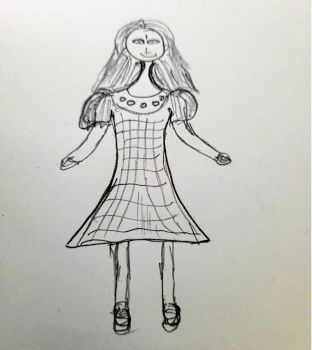Veranda Tales-Dancer blames the drummer

Storytelling has been an integral part of my life since childhood. I grew up listening to stories during the hot summer evenings and nights with my cousins. Mothers and grandmothers would gather all of us children for story time. It was usually pitch dark except for a very faint light coming from the flickering candle. Power cuts were as frequent as the hot and humid summer days. We all spread out on a cool concrete floor or on bamboo mats on the veranda intently listening to fascinating stories about kings, queens, princes, princesses, and peasants alike. Stories about love, life, families, and people entertained and taught us life skills. These stories transported us to distant worlds which were strange yet familiar. Often the same story told by two people sounded different as storytellers added new twists and turns adding their personal style and flair to the stories.
Storytelling wasn’t limited to summer evenings and bedtime. I was surrounded by adults that didn’t pass up an opportunity to share their wisdom using the art of storytelling. The rich and vibrant oral traditions include songs, poems, stories, and సామెతలు (Sametalu are proverbs in Telugu). Men and women sing songs as they work in the fields, grind grains and spices and other daily chores at their homes. Stories are often used to teach important life lessons, interpersonal skills, and survival skills. These stories and the time spent listening to them made our lives richer leaving an impression on me. This series is all about reliving those memories as I share these stories.
ఆడలేక మద్దెలోడిని అన్నది
Amma (అమ్మా is mother in Telugu) is very good with coming up with an apt సామెత (proverb) that fits pretty much any situation. She used them very effectively to make a point or as a soft discipline tactic. When she couldn’t come up with a సామెత (proverb), she would gesture with her index and middle fingers pointing to her two eyes and immediately point her index finger at us to indicate “I am watching you”. She channeled a scene from a Hindi movie named Do Aankhen Barah Haath she watched with her older brother when she was a teenager. The name of the movie translates to “Two Eyes and 12 Hands''. In this movie, the lead character reforms 6 very dangerous criminals as they come to admire him and feel like their reformer’s eyes observe them to keep them on the straight path. Amma used the gesture or simply said “Do Aankhen Do Haath (Two Eyes and 2 hands)” or “Do Aankhen Chaar Haath (Two Eyes and 4 hands)” and so on, depending on how many people she was keeping an eye on. If Amma asked me to do a chore and I got lost in a book instead, I would hear "Do Aankhen Do Haath”. I have to admit this was a routine occurrence since I am a self proclaimed bookworm.
Now back to the proverb I set out to talk about. When I complained about not being able to do something right and blamed it on somebody or something, Amma’s go to phrase was “It is like blaming the drummer when you can’t dance to the tune”. I might have complained about messing up attaching a Saree fall to a Saree and blamed it on the needle or the saree or the fall. Saree fall refers to a sturdy cotton or terry-cotton fabric strip measuring 5 inches wide and 3 meters long. This fabric is sewn and attached to the hem of a saree, so that it covers just the initial drape and pleats area. Fall is attached from the inner side of the saree, and must not be visible from the outside. This piece of fabric protects the hem of the Saree from tearing and adds a bit of weight for the Saree to drape gracefully.
Amma is a good seamstress and stitched all our clothes at home. She would make new dresses on birthdays and all the important festivals such as Deepawali, Dasarah and Sankranthi. She would save designs and embroidery patterns from Femina and other magazines. Femina is an Indian magazine and is the oldest women's English magazine in the India, having been published for almost six decades. She embroidered dresses with beautiful patterns. She made a dress for me with a smocking technique that I loved. She would stitch dresses and blouses with బుట్ట చేతులు (Butta Chetulu is Telugu for Puffed Sleeve).

When I was younger, she made dresses and then half skirts and matching blouses up until she graduated me to wearing పావడలు (Paavadalu are full skirts in Telugu). She would take me shopping to select fabric and would pick the one I liked. Then she would spend time measuring and cutting to make sure whatever she stitched would last for at least a couple of years. The clothing she made allowed room for growth. She would size them right with a couple of extra stitches that could be removed as I grew. The skirts had large folds at the bottom or in the middle adding to the aesthetic. These folds could be undone as I grew taller and the waistband would have a few folds that could be expanded as I grew. When I was about 16 years of age, she decided I was ready to wear sarees. After that, she would take me shopping to buy sarees. She would stitch the blouse and attach a saree fall. Attaching fall to a saree is a time consuming and laborious process. When I had time during summer or holidays, I would offer to help with finishing up hemming blouses or attaching the fall to a saree, either mine or hers.
She did all of her sewing on her prized very old Singer sewing machine, Tatayya (her father) gave her when she was a teenager. She carried it from place to place as we moved at least once every two years since Nanna’s job took us from one village to another all across Andhra Pradesh. Amma’s sewing machine came from the USA and was made in the early 1950s or 60s. It had a foot pedal to run it and a hand ring to start it. Amma took good care of her sewing machine and made repairs as needed. It had lasted for more than 60 years when she finally gave it up upon moving to a smaller place after Nanna passed away.
So anytime, I messed up the hemming and blamed it on the thread and needle, she would say – “Hmm, it is like a bad dancer blaming the drummer!”, and helped me redo the stitches. I would undo the stitches and redo them usually with a smile on my face thinking about the dancer and the drummer.
